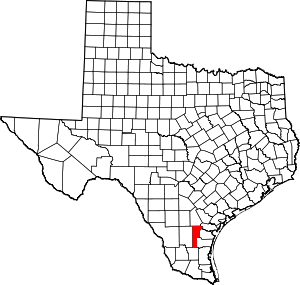San Diego, Texas
San Diego is a city in Duval and Jim Wells counties, Texas, United States. The population was 4,488 at the 2010 census.[5] It is located primarily in Duval County, of which it is the county seat.
San Diego, Texas | |
|---|---|
Location in the state of Texas | |
 | |
| Coordinates: 27°45′45″N 98°14′20″W | |
| Country | United States |
| State | Texas |
| Counties | Duval, Jim Wells |
| Government | |
| • Mayor | Sally Lichtenberger |
| Area | |
| • Total | 1.90 sq mi (4.92 km2) |
| • Land | 1.90 sq mi (4.92 km2) |
| • Water | 0.00 sq mi (0.00 km2) |
| Elevation | 308 ft (94 m) |
| Population (2010) | |
| • Total | 4,488 |
| • Estimate (2019)[2] | 4,221 |
| • Density | 2,220.41/sq mi (857.31/km2) |
| Time zone | UTC-6 (CST) |
| • Summer (DST) | UTC-5 (CDT) |
| ZIP code | 78384 |
| Area code(s) | 361 |
| FIPS code | 48-65180[3] |
| GNIS feature ID | 1346324[4] |
| Website | sandiegotexas |
Geography
San Diego is located at 27°45′45″N 98°14′20″W (27.762559, -98.238771).[6] It is 10 miles (16 km) west of Alice, 56 miles (90 km) west of Corpus Christi, and 84 miles (135 km) east of Laredo.
According to the United States Census Bureau, San Diego has a total area of 1.9 square miles (4.9 km2), all of it land.[5]
Demographics
| Historical population | |||
|---|---|---|---|
| Census | Pop. | %± | |
| 1880 | 1,572 | — | |
| 1890 | 1,877 | 19.4% | |
| 1940 | 2,674 | — | |
| 1950 | 4,397 | 64.4% | |
| 1960 | 4,351 | −1.0% | |
| 1970 | 4,490 | 3.2% | |
| 1980 | 5,225 | 16.4% | |
| 1990 | 4,983 | −4.6% | |
| 2000 | 4,753 | −4.6% | |
| 2010 | 4,488 | −5.6% | |
| Est. 2019 | 4,221 | [2] | −5.9% |
| U.S. Decennial Census[7] | |||
At the 2000 census there were 4,753 people, 1,548 households, and 1,187 families living in the city. The population density was 2,917.1 people per square mile (1,125.9/km2). There were 1,793 housing units at an average density of 1,100.4 per square mile (424.7/km2). The racial makeup of the city was 78.06% White, 0.27% African American, 0.78% Native American, 0.02% Asian, 0.04% Pacific Islander, 17.72% from other races, and 3.11% from two or more races. Hispanic or Latino of any race were 96.87%.[3]
Of the 1,548 households 40.5% had children under the age of 18 living with them, 47.3% were married couples living together, 24.4% had a female householder with no husband present, and 23.3% were non-families. 21.3% of households were one person and 11.0% were one person aged 65 or older. The average household size was 3.03 and the average family size was 3.52.
The age distribution was 32.9% under the age of 18, 9.5% from 18 to 24, 25.1% from 25 to 44, 19.4% from 45 to 64, and 13.1% 65 or older. The median age was 31 years. For every 100 females, there were 87.3 males. For every 100 females age 18 and over, there were 84.5 males.
The median household income was $19,250 and the median family income was $25,104. Males had a median income of $21,875 versus $14,622 for females. The per capita income for the city was $9,782. About 26.8% of families and 32.2% of the population were below the poverty line, including 44.3% of those under age 18 and 26.8% of those age 65 or over.
Education
The city is served by the San Diego Independent School District and is home to the San Diego High School Vaqueros.
See also
- Plan of San Diego
- History of San Diego
- The colorful story of San Diego, Texas from the Corpus Christi Caller
References
- "2019 U.S. Gazetteer Files". United States Census Bureau. Retrieved August 7, 2020.
- "Population and Housing Unit Estimates". United States Census Bureau. May 24, 2020. Retrieved May 27, 2020.
- "U.S. Census website". United States Census Bureau. Retrieved 2008-01-31.
- "US Board on Geographic Names". United States Geological Survey. 2007-10-25. Retrieved 2008-01-31.
- "Geographic Identifiers: 2010 Demographic Profile Data (G001): San Diego city, Texas". American Factfinder. U.S. Census Bureau. Archived from the original on February 13, 2020. Retrieved January 8, 2016.
- "US Gazetteer files: 2010, 2000, and 1990". United States Census Bureau. 2011-02-12. Retrieved 2011-04-23.
- "Census of Population and Housing". Census.gov. Retrieved June 4, 2015.


